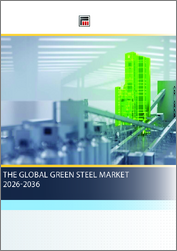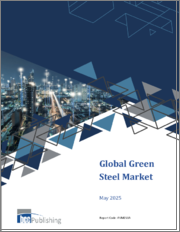
|
시장보고서
상품코드
1650835
유럽의 지속가능(재활용·그린) 철강 시장 : 최종사용자 용도별, 제품 유형별, 기술별, 국가별 - 분석과 예측(2024-2034년)Europe Sustainable (Recycled and Green) Steel Market: Focus on End-User Application, Product Type, Technology, and Country-Level Analysis - Analysis and Forecast, 2024-2034 |
||||||
유럽의 지속가능(재활용·그린) 철강 시장 규모는 2024년에 940억 9,000만 달러에 달했습니다.
이 시장은 5.31%의 CAGR로 확대하며, 2034년에는 1,578억 6,000만 달러에 달할 것으로 예측됩니다. 저탄소 건축자재에 대한 수요 증가와 엄격한 환경 법규가 이러한 성장을 가속하고 있습니다. 재활용 절차의 개선과 수소 기반 환원 기술 등 철강 생산의 기술 개발이 시장을 주도하는 주요 요인입니다. 또한 유럽 철강 산업은 전략적 제휴와 녹색 인프라 프로젝트에 대한 투자로 인해 탄소 인식이 높아지면서 지속가능성이 높아지고 있습니다.
| 주요 시장 통계 | |
|---|---|
| 예측 기간 | 2024-2034년 |
| 2024년 평가 | 940억 9,000만 달러 |
| 2034년 예측 | 1,578억 6,000만 달러 |
| CAGR | 5.31% |
엄격한 환경 기준과 지속가능성 목표를 충족시키기 위해 기업이 친환경, 재활용, 저탄소 철강 제품을 요구함에 따라 유럽의 지속가능한 철강 시장이 확대되고 있으며, CO2 배출량과 화석연료 의존도를 줄이기 위해 탄소 포집 통합 공정, 바이오 철강 생산, 친환경 수소 기반 철강(H2-DRI), 재활용 철강(스크랩 기반 생산) 등이 포함됩니다. 그린 수소 기반 철강(H2-DRI), 재활용 철강(스크랩 기반 생산) 등이 포함됩니다.
철강업체들은 유럽의 그린딜, 탄소배출권거래제(CBAM), 기업의 탄소배출권거래제(Net-Zero) 목표 등 여러 가지 요인으로 인해 친환경적인 선택에 대한 압박을 받고 있습니다. 전기로(EAF)와 직접 환원철(DRI) 기술에 대한 투자가 시장 성장을 주도하고 있으며, 자동차, 건설 및 제조 산업은 탄소 배출량을 줄이기 위해 지속가능한 철강을 채택하는 추세가 강화되고 있습니다.
높은 성장 잠재력에도 불구하고 높은 생산 비용, 기술적 한계, 그린수소의 가용성 등의 문제가 빠른 보급을 방해하고 있습니다. 그럼에도 불구하고 장려 정책, 탄소 가격제, 최종사용자 수요 증가로 인해 긍정적인 시장 환경이 조성되고 있으며, Voestalpine, SSAB, Arcelor Mittal과 같은 유명 기업은 친환경 제조 기술에 많은 투자를 하고 있습니다.
기술 혁신, 규제 지원, 녹색 조달에 대한 기업의 노력으로 인해 지속가능한 철강 시장은 유럽이 2050년까지 기후 중립에 가까워짐에 따라 크게 성장할 것으로 예상됩니다.
유럽의 지속가능(재활용·그린) 철강 시장에 대해 조사했으며, 시장의 개요와 최종사용자 용도별, 제품 유형별, 기술별, 국가별 동향 및 시장에 참여하는 기업의 개요 등을 제공하고 있습니다.
목차
개요
제1장 시장
- 동향 : 현재 및 향후 영향 평가
- 공급망의 개요
- 연구개발 리뷰
- 규제 상황
- 주요 세계 이벤트별 영향 분석 - COVID-19 팬데믹, 러시아/우크라이나 전쟁, 중동 위기가 지속가능(재활용 및 그린) 철강 시장에 미치는 영향
- 시장 역학의 개요
- 주요 철강 제조업체와 넷 제로 목표 리스트
- 스타트업의 상황
- 세계 그린 철강 프로젝트와 개발
제2장 지역
- 지역별 개요
- 촉진요인과 억제요인
- 유럽
제3장 시장 - 경쟁 벤치마킹과 기업 개요
- 향후 전망
- 지역적 평가
- 기업 개요
- ArcelorMittal
- H2 Green Steel
- SSAB AB
- thyssenkrupp Steel Europe
- 기타 주요 제조업체의 리스트
- LIBERTY Steel Group
- Lech-Stahlwerke GmbH
- voestalpine AG
- Outokumpu
- Blastr Green Steel AS
제4장 조사 방법
KSA 25.02.26Introduction to Europe Sustainable (Recycled and Green) Steel Market
The Europe sustainable (recycled and green) steel market was valued at $94.09 billion in 2024 and is projected to grow at a CAGR of 5.31%, reaching $157.86 billion by 2034. The growing need for low-carbon construction materials and stringent environmental laws are driving this expansion. Technological developments in steel production, such as improved recycling procedures and hydrogen-based reduction techniques, are major factors driving the market. Furthermore, the European steel industry is becoming more carbon-conscious and sustainable as a result of strategic alliances and investments in green infrastructure projects.
Market Introduction
| KEY MARKET STATISTICS | |
|---|---|
| Forecast Period | 2024 - 2034 |
| 2024 Evaluation | $94.09 Billion |
| 2034 Forecast | $157.86 Billion |
| CAGR | 5.31% |
The market for sustainable steel in Europe is expanding as businesses move toward green, recycled, and low-carbon steel products to satisfy strict environmental standards and sustainability objectives. In order to lessen CO2 emissions and dependency on fossil fuels, this market includes carbon capture-integrated processes, bio-based steel production, green hydrogen-based steel (H2-DRI), and recycled steel (scrap-based production).
Steelmakers are being pushed toward more environmentally friendly options by major forces such as the European Green Deal, the Carbon Border Adjustment Mechanism (CBAM), and corporate net-zero targets. While investments in electric arc furnaces (EAFs) and direct reduced iron (DRI) technologies are driving market growth, the automotive, construction, and manufacturing industries are increasingly embracing sustainable steel to reduce their carbon footprint.
Despite its high growth potential, challenges such as high production costs, technological limitations, and the availability of green hydrogen impede rapid adoption. Nonetheless, a positive market environment is being created by encouraging policies, carbon pricing schemes, and rising end-user demand. Prominent firms like Voestalpine, SSAB, and Arcelor Mittal are making significant investments in environmentally friendly production techniques.
Due to innovation, regulatory support, and growing corporate commitments to green procurement, the sustainable steel market is expected to grow significantly as Europe approaches climate neutrality by 2050.
Market Segmentation
Segmentation 1: by End-User Application
- Transportation
- Building and Construction
- Furniture and Appliances
- Mechanical Equipment and Tools
- Packaging
- Others
Segmentation 2: by Product Type
- Recycled Steel
- Green Steel
Segmentation 3: by Technology
- Sustainable Steel
- Electric Arc Furnace (EAF)
- Blast Furnace-Basic Oxygen Furnace (BF-BOF)
- Others
- Green Steel
- Electric Arc Furnace (EAF)
Renewable - Electric Arc Furnace (R-EAF)
Hydrogen Direct Reduced Iron - Electric Arc Furnace (H2 DRI-EAF)
- Others
Segmentation 4: by Region
- Europe: Germany, Sweden, France, Italy, Spain, U.K., and Rest-of-Europe
How can this report add value to an organization?
Product/Innovation Strategy: The product segment helps the reader understand the different applications of the sustainable steel products available based on application (transportation, building and construction, furniture and appliances, mechanical equipment and tools, packaging, and others), product type (recycled steel and green steel), technology type (electric arc furnace (EAF), blast furnace-basic oxygen furnace (BF-BOF), and others. The market is poised for significant expansion with ongoing technological advancements, increased investments, and growing awareness of the importance of sustainable steel. Therefore, the Europe sustainable steel business is a high-investment and high-revenue generating model.
Growth/Marketing Strategy: The Europe sustainable steel market has been growing at a rapid pace. The market offers enormous opportunities for existing and emerging market players. Some of the strategies covered in this segment are mergers and acquisitions, product launches, partnerships and collaborations, business expansions, and investments. The strategies preferred by companies to maintain and strengthen their market position primarily include product development.
Competitive Strategy: The key players in the Europe sustainable steel market analyzed and profiled in the study include manufacturers and recyclers. Additionally, a comprehensive competitive landscape such as partnerships, agreements, and collaborations are expected to aid the reader in understanding the untapped revenue pockets in the market.
Key Market Players and Competition Synopsis
The companies that are profiled in the sustainable steel market have been selected based on inputs gathered from primary experts and analyzing company coverage, product portfolio, and market penetration.
Some of the prominent names in the sustainable steel market are:
- ArcelorMittal
- H2 green steel
- SSAB AB
- thyssenkrupp Steel Europe
Table of Contents
Executive Summary
Scope and Definition
1 Markets
- 1.1 Trends: Current and Future Impact Assessment
- 1.1.1 Circular Economy and Recycling
- 1.1.2 Technological Advancements and Rising Research and Developments
- 1.1.3 Carbon Capture and Emission Reduction
- 1.2 Supply Chain Overview
- 1.2.1 Value Chain Analysis
- 1.2.2 Market Map
- 1.2.3 Pricing Forecast
- 1.3 Research and Development Review
- 1.3.1 Patent Filing Trend (by Number of Patents, Country)
- 1.4 Regulatory Landscape
- 1.5 Impact Analysis for Key Global Events- COVID-19 Pandemic, Russia/Ukraine War, or Middle East Crisis on Sustainable (Recycled and Green) Steel Market
- 1.5.1 COVID-19 Pandemic
- 1.5.2 Russia/Ukraine War or Middle East Crisis
- 1.6 Market Dynamics Overview
- 1.6.1 Market Drivers
- 1.6.1.1 Construction Industry's Shift toward Sustainable Materials
- 1.6.1.2 Government Regulations and Net-Zero Targets
- 1.6.1.3 Use of Renewable Energy Sources in Steel Production
- 1.6.2 Market Restraints
- 1.6.2.1 Limited Availability of Green Technologies and Infrastructure for Sustainable Steel Production
- 1.6.2.2 High Cost Associated with Implementing Green Steel Production Methods
- 1.6.3 Market Opportunities
- 1.6.3.1 Increasing Demand for Sustainable Infrastructure and Green Construction Projects
- 1.6.3.2 Rising Collaborations between Steel Producers and End Users
- 1.6.1 Market Drivers
- 1.7 List of Key Steel Manufacturers and Their Net-Zero Targets
- 1.8 Start-Up Landscape
- 1.8.1 Key Start-Ups in the Ecosystem
- 1.9 Global Green Steel Projects and Developments
2 Regions
- 2.1 Regional Summary
- 2.2 Drivers and Restraints
- 2.3 Europe
- 2.3.1 Regional Overview
- 2.3.2 Driving Factors for Market Growth
- 2.3.3 Factors Challenging the Market
- 2.3.4 Application
- 2.3.5 Product
- 2.3.6 Europe (by Country)
- 2.3.6.1 Germany
- 2.3.6.1.1 Application
- 2.3.6.1.2 Product
- 2.3.6.2 Sweden
- 2.3.6.2.1 Application
- 2.3.6.2.2 Product
- 2.3.6.3 France
- 2.3.6.3.1 Application
- 2.3.6.3.2 Product
- 2.3.6.4 Italy
- 2.3.6.4.1 Application
- 2.3.6.4.2 Product
- 2.3.6.5 Spain
- 2.3.6.5.1 Application
- 2.3.6.5.2 Product
- 2.3.6.6 U.K.
- 2.3.6.6.1 Application
- 2.3.6.6.2 Product
- 2.3.6.7 Rest-of-Europe
- 2.3.6.7.1 Application
- 2.3.6.7.2 Product
- 2.3.6.1 Germany
3 Markets - Competitive Benchmarking & Company Profiles
- 3.1 Next Frontiers
- 3.2 Geographic Assessment
- 3.3 Company Profiles
- 3.3.1 ArcelorMittal
- 3.3.1.1 Overview
- 3.3.1.2 Top Products/Product Portfolio
- 3.3.1.3 Top Competitors
- 3.3.1.4 Target Customers/End Users
- 3.3.1.5 Key Personnel
- 3.3.1.6 Analyst View
- 3.3.1.7 Market Share, 2023
- 3.3.2 H2 Green Steel
- 3.3.2.1 Overview
- 3.3.2.2 Top Products/Product Portfolio
- 3.3.2.3 Top Competitors
- 3.3.2.4 Target Customers
- 3.3.2.5 Key Personnel
- 3.3.2.6 Analyst View
- 3.3.2.7 Market Share, 2023
- 3.3.3 SSAB AB
- 3.3.3.1 Overview
- 3.3.3.2 Top Products/Product Portfolio
- 3.3.3.3 Top Competitors
- 3.3.3.4 Target Customers
- 3.3.3.5 Key Personnel
- 3.3.3.6 Analyst View
- 3.3.3.7 Market Share, 2023
- 3.3.4 thyssenkrupp Steel Europe
- 3.3.4.1 Overview
- 3.3.4.2 Top Products/Product Portfolio
- 3.3.4.3 Top Competitors
- 3.3.4.4 Target Customers/End Users
- 3.3.4.5 Key Personnel
- 3.3.4.6 Analyst View
- 3.3.4.7 Market Share, 2023
- 3.3.1 ArcelorMittal
- 3.4 List of Other Key Sustainable Steel Manufacturers
- 3.4.1 LIBERTY Steel Group
- 3.4.1.1 Overview
- 3.4.1.2 Top Products/Product Portfolio
- 3.4.1.3 Top Competitors
- 3.4.1.4 Target Customers/End Users
- 3.4.1.5 Key Personnel
- 3.4.1.6 Analyst View
- 3.4.1.7 Market Share, 2023
- 3.4.2 Lech-Stahlwerke GmbH
- 3.4.2.1 Overview
- 3.4.2.2 Top Products/Product Portfolio
- 3.4.2.3 Top Competitors
- 3.4.2.4 Target Customers/End Users
- 3.4.2.5 Key Personnel
- 3.4.2.6 Analyst View
- 3.4.2.7 Market Share, 2023
- 3.4.3 voestalpine AG
- 3.4.3.1 Overview
- 3.4.3.2 Top Products/Product Portfolio
- 3.4.3.3 Top Competitors
- 3.4.3.4 Target Customers/End Users
- 3.4.3.5 Key Personnel
- 3.4.3.6 Analyst View
- 3.4.3.7 Market Share, 2023
- 3.4.4 Outokumpu
- 3.4.4.1 Overview
- 3.4.4.2 Top Products/Product Portfolio
- 3.4.4.3 Top Competitors
- 3.4.4.4 Target Customers/End Users
- 3.4.4.5 Key Personnel
- 3.4.4.6 Analyst View
- 3.4.4.7 Market Share, 2023
- 3.4.5 Blastr Green Steel AS
- 3.4.5.1 Overview
- 3.4.5.2 Top Products/Product Portfolio
- 3.4.5.3 Top Competitors
- 3.4.5.4 Target Customers/End Users
- 3.4.5.5 Key Personnel
- 3.4.5.6 Analyst View
- 3.4.5.7 Market Share, 2023
- 3.4.1 LIBERTY Steel Group
4 Research Methodology
- 4.1 Data Sources
- 4.1.1 Primary Data Sources
- 4.1.2 Secondary Data Sources
- 4.1.3 Data Triangulation
- 4.2 Market Estimation and Forecast



















